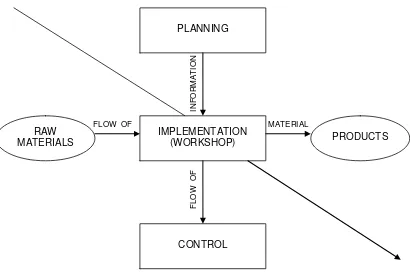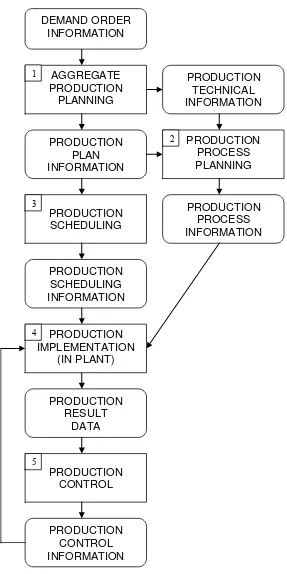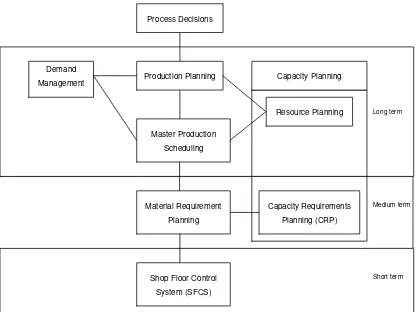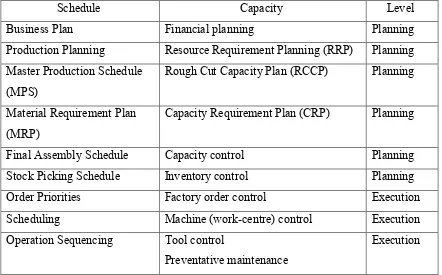KOLEJ UNIVERSITI TEKNIKAL KEBANGSAAN
MALAYSIA
Line Balancing Optimization for
Single Model Assembly Line
Thesis submitted in accordance with the requirements of the Kolej Universiti Teknikal Kebangsaan Malaysia for the Degree of
Bachelor of Engineering (Honours) Manufacturing (Process)
By
Irwan bin Taib
APPROVAL
This thesis submitted to the senate of KUTKM and has been accepted as fulfillment of the requirement for the degree of Bachelor of Manufacturing Engineering (Honours) (Manufacturing Process). The members of the supervisory committee are as follows:
Signature : ……….
Supervisor’s Name : ENCIK TAUFIK BIN SYAHRONI
DECLARATION
I here, declare this thesis entitled “Line Balancing Optimization for Single Model Assembly Line” is the result of my own research
except as cited in the references.
Signature : ………
Author’s Name : IRWAN BIN TAIB
ABSTRACT
Manual assembly line technology has made a significant contribution to the development of manufacturing industry in the twentieth century. It remains an important production system throughout the world in the manufacture of automobiles, consumer appliances and other assembled products made in large quantity such as television, cameras, washing machine and audio equipments. This project is about the line balancing optimization for single model assembly line in the production line which a part of the production scheduling. The main objective is to explore the companies with suitable with the project especially use conveyor system, learn and collect data from the existing system using the time study analysis and proposed the optimum system based on parameter such as cycle time, line efficiency, idle time and balance delay. The method that were used in this project are heuristics method consist the 3 algorithm such as Largest Candidate Rule, Kilbridge and Wester Method and Ranked Positional Method. The result from this project should determine the best method from the proposed system based on the parameter states before. The performances of a given line balancing algorithm depends on the problems to be solved. Some line balancing methods works better on some problems while other method work better on other problems.
DEDICATION
For my beloved parents,
ACKNOWLEDGEMENT
Alhamdulillah….Thank to might god Allah s.w.t for giving me the fulfillment and energy to complete my thesis project for final year. Since the project goes on, I have a great experiences and knowledge about the project that was implementing by me. I have fully satisfied with this project even though I know it is hard and need a lot of work to do to finish this project. At the end, I finally come out with the good result.
TABLE OF CONTENTS
2. LITERATURES REVIEW 3
2.1 Introduction to Manufacturing Systems 3
2.2 Production Planning System 8
2.2.1 Production Planning 11
2.2.2 Master Production Schedule (MPS) 12
2.2.3 Material Requirement Planning (MRP) 13
2.2.4 Production Scheduling 14
2.3 Categories in the System (Pull versus Push System) 16
2.4 Introduction to Line Balancing 18
2.5 Objectives of Assembly Line Balancing 19
2.6 The Purpose of Line Balancing 20
2.7 Advantages and Disadvantages of Line Balancing 20
2.9 Types of Line Balancing Algorithms 22
2.9.1 Largest Candidate Rule 22
2.9.2 Kilbridge and Wester Method 24
2.9.3 Ranked Positional Weights Method 28
2.9.4 COMSOLE 31
2.9.5 CALB 31
2.10 Parameter Used 32
2.10.1 Theoretical Minimum Number of Workstation 32
2.10.2 Cycle Time 32
2.10.3 Idle Time 33
2.10.4 Line Efficiency 33
2.10.5 Balance Delay 33
2.10.6 Balance Delay after Process 34
2.10.7 Balance Efficiency after Process 34
3. MATERIALS AND METHODS/METHODOLOGY 35
3.1 Introduction 35
3.2 Research Methodology 36
3.3 Research Design 41
4.5.3 Kilbridge and Wester Method 64
4.5.4 Ranked Positional Weight Method 65
5. DISCUSSIONS 66
5.1 Introduction 66
5.2 Overall Results 66
5.2.1 Existing System 67
5.2.2 Largest Candidate Rule 68
5.2.3 Kilbridge and Wester Method 69
5.2.4 Ranked Positional Weight Method 70
5.3 The Best Method 71
6. SUMMARY AND CONCLUSION 72
6.1 Conclusion 72
6.2 Recommendations for Future Work 73
REFERENCES 74
APPENDICES
A Example 1: A Problem for Line Balancing B Time Study: Assembly Line Balancing Result C Layout of Assembly Line
D List of Results for Standard Data
LIST OF FIGURES
2.1 Three flow concerning manufacturing: flow of material, flow of 5 information and flow of cost
2.2 The procedural aspects of manufacturing system: the flow of 7 information
2.3 Production Planning and Control Framework 8
2.4 The material flow process in a push system 17
2.5 The material flow process in a pull system 18
2.6a Assignment of elements according to the largest candidate rule 24 2.6b Physical of sequence of station with assigned work elements 24 2.7 Work elements in examples problem arranged into columns 25
for the Kilbridge and Wester method
3.1 Flowchart process of the Research Methodology 40
3.2 Steps in time study 42
3.3 Various allowances to build standard time 48
3.4 How a standard time for a simple manual job is made up 48
3.5 Time study board 49
3.6 Stop watch 50
3.7 Assembly Line Balancing Step-by-Step Form 53
4.1 Zen Micro MP3 Player 59
5.1 Component of cycle time at all station on Existing System 67 5.2 Component of cycle time at all station on Largest 68
Candidate Rule
5.3 Component of cycle time at all station on Kilbridge and 69 Wester Method
LIST OF TABLES
2.1 Production Planning and Control Component 10
2.2 Work Elements Arranged According to Tek value for 22
the Largest Candidate Rule
2.3 Work Elements Assigned to Stations According to the 23 Largest Candidate Rule
2.4 Work Elements Listed According to columns from 26 Figure 2.7 for the Kilbridge and Wester method
2.5
Work Elements Assigned to Stations According to the 27 Kilbridge and Wester method2.6
List of Elements Ranked According to Their Ranked 29 Positional Weight (RPW) method2.7
Work Elements Assigned to Stations According to the 30 Ranked Positional Weight (RPW) method3.1 Process Planning for PSM I 55
3.2 Process Planning for PSM II 56
4.1 Specification of Zen Micro 60
4.2 Result of Standard Data 62
4.3 Result of Largest Candidate Rule 63
4.4 Result of Kilbridge and Wester Method 64
4.5 Result of Ranked Positional Weight Method 65
LIST OF ABBREVIATIONS, SYMBOLS, SPECIALIZED
NOMENCLATURE
AGV Automated Guided Vehicle
BD Balance Delay
BOM Bill of Material
CALB Computer-Aided Line Balancing
COMSOAL Computer Method of Sequencing Operation for Assembly Line C Cycle time for the balanced
CT Cycle time
DFA Design for Assembly Eb Balancing Efficiency
LCR Largest Candidate Rules
LE Line Efficiency
MPS Master Production Schedule MPR Material Requirement Planning
N Theoretical minimum number of workstation n number of work elements
PPC Production Planning and Control System Rc Cycle rate for the line
Rp Average production rate
PSM Projek Sarjana Muda RPW Ranked Position Weight
T Total time for completing all task Tek Time to perform work element k (min)
Tc Cycle time of the line
Ti Time for work element
Tmax Maximum work element time
Tr Repositioning time
CHAPTER 1
INTRODUCTION
1.1 Background
An assembly line, which consists of a sequence of workstations, is an efficient method of manufacturing high volume products such as automobile parts and microcomputers. In designing assembly line, it is common practice to “balance” the line so that a more uniform flow is maintained.
As in a progressive assembly line where successive production stages (workstation) take the form of the conveyer like system and work is performed continuously, a balance among production stages should be kept in such a way that a smooth material flow is obtained by almost equalizing the production times at all production stages, thus minimizing idle times at the workstations. The line balancing aims at minimum cycle time, minimum number of workstations, optimal grouping of work elements, etc. (Richard C. Doff, Andrew Kusiak, 1994)
1.2 Problem Statement
design, because that is when the number of components in the product is determined and decision are made about how these components will be assembled. Once these decisions have been made, there is a little that can be done in manufacturing to influence assembly costs.
1.3 Objective of the Research
There are a few objectives that must be achieved in the project:
a. To understand production line, design for assembly and line balancing algorithms.
b. To identify parameters of design for single model assembly line. c. To analysis single model assembly line, existing and proposed. d. To optimize production time in assembly line.
1.4 Scope of the Project
CHAPTER 2
LITERATURES REVIEW
2.1 Introduction in Manufacturing Systems
The phrase manufacturing system was employed as early as in 1815 by Owen, a utopian socialist; this term is not new. At that time it mean factory system, or as serious of inventions that was created during the industrial revolution in Great Britain about 200 years ago. Early in this century, the system view in management and manufacturing was emphasized. Nowadays, the term manufacturing system signifies a broad systematic view of manufacturing. It is basically recognized as a production function that converts the raw materials into the finished products, and this function is controlled by the management system that performs planning and control (K. Hitomi, 1975). It should be noted that from a wider viewpoint the manufacturing (production) plays a role in constructing the international structural power together with the financial system, the security system and the knowledge system (S. Strange, 1988)
On the basis of such concepts and views of the meanings of manufacturing and systems so far discussed, manufacturing (or production) systems can now be defined in the following three aspects (K. Hitomi, 1975):
supplementary devices. Thus the structural aspect of the manufacturing system forms a static spatial structure of a plant, i.e., the plant layout. This aspect can be viewed as a production system. This phrase appeared in 1907. Since 1943 it has been also used to mean the inference mechanism operated by knowledge based systems in the field of artificial intelligence (a different terminology should be introduced for this meaning).
2. The Transformational Aspect of Manufacturing Systems. Based on a transformational (or functional) definition of the system, the manufacturing system is defined as the conversion process of the factors of production, particularly the raw materials, into the finished products, aiming at a maximum productivity. This system is concerned with the flow of materials (or material flow). This is a common method of defining production systems or, in some cases, machining systems.
Figure 2.1: Three flows concerning manufacturing: flow of material, flow of information and flow of cost.
As previously mentioned, production management is the procedure of manufacturing systems. This consists of the following five stages, as represented in Figure 2.2 (K. Hitomi, 1978).
1. Aggregate Production Planning. This determines the kinds of product items and the quantities to be produced during the specified time periods. 2. Production Process Planning. This determines the production processes
(or process routes) by which raw materials are effectively transformed into finished products.
3. Production Scheduling. This determines an actual implementation plan defining the time schedule for every job contained in the process route adopted, i.e., when, with what machine, and who does what operation? 4. Production Implementation. This function executes actual production
operations according to the time schedule.
5. Production Control. Whenever the actual production progress and performances deviate from the production standards (plans and schedules) set at the planning stages 1, 2, and 3 above, such deviations are measured and modifications are appropriately made.
Stages 1, 2, and 3 constitute planning. Stage 4 is implementation, which forms the flow of materials. Stage 5 is control. In production management, the cycle of planning, implementation, and control plays a basic role in effective manufacturing activities. Stage 2 deals with basic production technology; it is named the flow of technological information. While a series of functions-stages 1, 3 and 5 is concerned with management activities; it is named the flow of managerial information.
2.2 Production Planning System
Production Planning and control Activities deal with the planning and control of manufacturing processes and therefore include material, machines, operators, suppliers, customers and products. The operational tasks of an industrial enterprise can be referred to as the production planning and control system (PPC), and their problem s encompass a wide range of fields and industries. Their solution strongly depends on many interrelated aspects such as market environment, production environment, production strategy, human resources and degree of automation. Figure 2.3 is outlines the production planning and control framework and follows the one suggested by Vollman (1991).
Figure 2.3: Production Planning and Control Framework
With the present trend in manufacturing, products have to be delivered at competitive cost, at the required time and in an acceptable quality to the customer. Competitive cost, timely delivery of products and attainment of high quality require proper planning and effective control of work through a manufacturing system. Production planning is complex because it takes into consideration all the various aspects that are necessary in order to achieve the business and strategic plans of a manufacturing firm. Typically, input to a production planning system is in numeric form such as the number of products to be produced or assembled per week. From this, planned order release has to be determined, each job has to be scheduled and work centres have to be loaded. In each stage, a check on capacity is necessary in order to ensure that equipment and workforce are available to meet production target. Input to a production planning system is composed of forecast from marketing department and also customer orders.
At the top of a production planning and control system is aggregated medium range plan that need to be dis-aggregated into master production schedule. System forecast, customer order, and manual forecast from the mar-keting/sales department are input into the master production schedule for computing the total demand. The total demand is the net requirement used to drive a material requirement planning system. We now discuss requirement planning functions in more details.
Table 2.1: Production Planning and Control Component
Schedule Capacity Level
Business Plan Financial planning Planning
Production Planning Resource Requirement Planning (RRP) Planning Master Production Schedule
(MPS)
Rough Cut Capacity Plan (RCCP) Planning
Material Requirement Plan (MRP)
Capacity Requirement Plan (CRP) Planning
Final Assembly Schedule Capacity control Planning
Stock Picking Schedule Inventory control Planning
Order Priorities Factory order control Execution
Scheduling Machine (work-centre) control Execution
Operation Sequencing Tool control
Preventative maintenance
Execution



